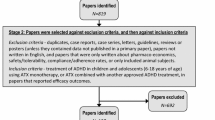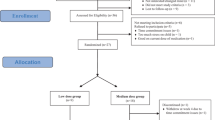Poor attention and motor restlessness are common in Williams syndrome (WS) children, and attention deficit hyperactivity disorder (ADHD) is at least as prevalent in WS as in other mentally handicapped groups. We determined the effectiveness of methylphenidate in two children with WS and ADHD. Each child underwent a double-blind dose-determining assessment to select the optimum dose for “N of 1” trials, which consisted of single subject, placebo-controlled randomized controlled trials with multiple crossovers. A regimen of 5 mg in the morning and 2.5 mg at noon was determined by consensus for both trials. Response to MPH was assessed using parent and teacher Conners ratings, and analyzed separately for each child, using mixed model ANOVA. No significant differences in behavioral ratings between medication and placebo weeks were found during the “N of 1 trials.” We conclude that methylphenidate was not superior to placebo in decreasing ADHD symptoms in these two children with Williams syndrome.

Similar content being viewed by others
REFERENCES
Aman, M. G., Buican, B., and Arnold, L. E. (2003). Methylphenidate treatment in children with borderline IQ and mental retardation: Analysis of three aggregated studies. J. Child Adolesc. Psychopharmacol. 13: 29–40.
Aman, M. G., Pejeau, C., Osborne, P., Rojahn, J., and Handen, B. (1996). Four-year follow-up of children with low intelligence and ADHD. Res. Dev. Disabil. 17: 417–432.
Aman, P. A., Waltonen, S. J., Olson, K. A., Theye, F. W., Ban Erem, A. J., and LaPlant, R. J. (1993). Placebo-controlled evaluation of MPH side effects. Pediatrics 91: 1101–1106.
American Psychological Association (1994). Diagnostic and Statistical Manual of Mental Disorders (4th edn.), American Psychiatric Association, Washington, DC, pp. 78–85.
Barkley, R. A., McMurray, M. B., Edelbrock, C. S., Tucker, E. E., and Cowdry, R. W. (1990). Side-effects of methylphenidate in children with attention deficit hyperactivity disorder: A systemic, placebo-controlled evaluation. Pediatrics 86: 184–192.
Bawden, H. N., MacDonald, G. W., and Shea, S. (1997). Treatment of children with Williams syndrome with methylphenidate. J. Child Neurol. 12: 248–252.
Benavidez, D. A. (1994). Attention deficit-hyperactivity disorder among mentally retarded children. Res. Dev. Disab. 55: 67–79.
Biederman, J., Spencer, T., and Wilens, T. (2004). Evidence-based pharmacotherapy for attention-deficit hyperactivity disorder. Int. J. Neuropsychopharmacol. 7: 77–97.
Daniels, S. R., Loggie, J. M. H., Schwartz, D. C., Strife, J. L., and Kaplan, S. (1985). Systemic hypertension secondary to peripheral vascular anomalies in patients with Williams Syndrome. J. Pediatr. 106: 249–251.
Dunn, L. M., and Dunn, L. M. (1981). The Peabody Picture Vocabulary Test-Revised, American Guidance Service, Circle Pines, Minnesota.
Einfeld, S. L., Tonge, B. J., and Rees, V. W. (2001). Longitudinal course of behavioral and emotional problems in Williams syndrome. Am. J. Mental Retard. 106: 73–81.
Epstein, M. H., Cullinan, D., and Gadow, K. (1986). Teacher ratings of hyperactivity in learning-disabled, emotionally disturbed and mentally retarded children. J. Spec. Ed. 22: 219–229.
Ewart, A. K., Morris, C. A., Atkinson, D., Jin, W., Sternes, K., Spallone, P., Stock, A. D., Leppert, M., and Keating, M. T. (1993). Hemizygosity at the elastin locus in a developmental disorder, Williams Syndrome. Nat. Genet. 5: 11–16.
Finegan, J., Sitarenios, G., Smith, M., Meschino, W. (1994). Attention deficit hyperactivity disorder in children with Williams Syndrome: Preliminary findings. Presented at the Sixth Williams Syndrome Association National Conference, San Diego, CA, 1994.
Flemenbaum, A. (1972). Hypertensive episodes after adding methylphenidate (MPH) to tricyclic antidepressants. Psychosomatics 13: 265–268.
Gosch, A., Pankau, R. (1994). Social-emotional and behavioural adjustment in children with Williams–Beuren Syndrome. Am. J. Med. Genet. 53: 335–339.
Guyatt, G., Sackett, D., Taylor, D. W., Chong, J., Roberts, R., Pugsley, S. (1986).Determining optimal therapy—Randomized trials in individual patients. New. Engl. Med. 314: 889–892.
Hale, J. B., How, S. K., Dewitt, M. B., and Coury, D. L. (2001). Discriminant validity of the Conners’ scales for ADHD subtypes. Curr. Psychol.: Dev. Learn. Pers. Social 20: 231–249.
Handen, B. L., Breaux, A. M., Gosling, A., Ploof, D. L., and Feldman, H. (1990). Efficacy of methylphenidate among mentally retarded children with ADHD. Pediatrics 86: 922–930.
Handen, B. L., Breaux, A. M., Janosky, J., McAuliffe, S., Feldman, H., and Gosling, A. (1992). Effects and noneffects of methylphenidate in children with mental retardation and ADHD. J. Am. Acad. Child Adolesc. Psychol. 31: 455–461.
Handen, B. L., Janosky, J., McAuliffe, S., Breaux, A. M., and Feldman, H. (1994). Prediction of response to methylphenidate among children with ADHD and mental retardation. J. Am. Acad. Child Adolesc. Psychol. 33: 1185–1193.
Jacobson, J. W. (1982). Problem behaviour and psychiatric impairment within a developmentally disabled population I: Behaviour frequency. Appl. Res. Mental Retard. 3: 121–139.
Klein-Schwartz, W., and McGrath, J. (2003). Poison centers’ experience with methylphenidate abuse in pre-teens and adolescents. J. Am. Acad. Child Adolesc. Psychiatry 42: 288–294.
Koller, H., Richardson, S. A., Katz, M., and McLaren, J. (1983). Behavior disturbance since childhood among a 5-year birth cohort of all mentally retarded young adults in a city. Am. J. Mental Deficienc. 87: 386–395.
Mayes, S. D., Crites, D. L., Bixler, F. J., Humphrey, F. J., and Mattison, R. E. (1994). Methylphenidate and ADHD: Influence of age I.Q. and neurodevelopmental status. J. Autism Dev. Disord. 36: 1099–1107.
Mervis, C. B. (2003). Williams syndrome: 15 years of psychological research. Dev. Neuropsychol. 23: 1–12.
Nicholson, W. R., and Hockey, K. A. (1993). Williams syndrome: A clinical study of children and adults. J. Pediatr. Child Health. 29: 468–472.
Pastor, P. N., and Reuben, C. A. (2002). Attention deficit disorder and learning disability: United States, 1997–98. Vital Health Stat. 10: 1–12.
Pearson, D. A., Lane, D. M., Santos, C. W., Casat, C. D., Jerger, S. W., Loveland, K. A., Faria, L. P., Mansour, R., Henderson, J. A., Payne, C. D., Roache, J. D., Lachar, D., and Cleveland, L. A. (2005a). Effects of methylphenidate treatment in children with mental retardation and ADHD: Individual variation in medication response. J. Am. Acad. Child Adolesc. Psychiatry 43: 686–698.
Pearson, D. A., Santos, C. W., Casat, C. D., Lane, D. M., Jerger, S. W., Roache, J. D., Loveland, K. A., Lachar, D., Faria, L. P., Payne, C. D., and Cleveland, L. A. (2005b). Treatment effects of methylphenidate on cognitive functioning in children with mental retardation and ADHD. J. Am. Acad. Child Adolesc. Psychiatry 43: 677–685.
Pearson, D. A., Santos, C. W., Roache, J. D., Casat, C. D., Loveland, K. A., Lachar, D., Lane, D. M., Faria, L. P., and Cleveland, L. A. (2003). Treatment effects of methylphenidate on behavioral adjustment in children with mental retardation and ADHD. J. Am. Acad. Child Adolesc. Psychiatry 42: 209–216.
Philops, C. J., Smith, B., and Broadhurst, A. (1973). The draw-a-man test: A study in scoring methods, validity and norms with English children at 5 and 11 years. Clinics Dev. Med. 46.
Porter, M. A., and Coltheart, M. (2005) Cognitive heterogeneity in Williams syndrome. Dev. Neuropsychol. 27: 275–306.
Power, T. J., Blum, N. J., Jones, S. M., and Kaplan, P. E. (1997). Brief report: Response to methylphenidate in two children with Williams syndrome. J. Autism Dev. Disord. 27: 79–87.
Reich, W., Herjanic, B., Welner, Z., Gandhy, P. R. (1982). Development of a structured psychiatric interview for children: Agreement of diagnosis comparing child and parent interviews. J. Abnorm. Child Psychol. 10: 325–336.
Stromme, P., Bjornstad, P. G., and Ramstad, K. (2002). Prevalence estimation of Williams syndrome. J. Child Neurol. 17: 269–271.
Swanson, J. M., and Kinsbourne, M. K. (1976). Stimulant-related state-dependent learning in hyperactive children. Science 192: 1354–1357.
Wechsler, D. (1991). Wechsler Intelligence Scale for Children (WISC-III), The Psychological Corporation, San Antonio, TX.
Welner, Z., Reich, W., Herjanic, B., Jung, K. G., and Amado, H. (1987). Reliability, validity, and parent-child agreement studies of the Diagnostic Interview for Children and Adolescents (DICA). J. Am. Acad. Child Adolesc. Psychol. 26: 649–653.
Werry, J. S., Sprague, R. L., and Cohen, M. N. (1975). Conners teacher rating scale for use in drug studies with children: An empirical study. J. Abnorm. Child Psychol. 3: 217–229.
Williams, J. C. P., Barrat-Boyes, B. G., and Lowe, J. B. (1961). Supravalvular aortic stenosis. Circulation 24: 1311–318.
Author information
Authors and Affiliations
Corresponding author
Rights and permissions
About this article
Cite this article
Zwaigenbaum, L., Dick, P., Handley-Derry, M. et al. “N of 1” Trials of Methylphenidate in Two Children with Williams Syndrome and Attention Deficit Hyperactivity Disorder. J Dev Phys Disabil 18, 45–58 (2006). https://doi.org/10.1007/s10882-006-9005-9
Published:
Issue Date:
DOI: https://doi.org/10.1007/s10882-006-9005-9




